History of Crete
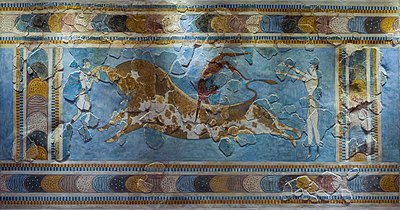
The history of Crete goes back to the
During the
Prehistoric Crete
This section needs additional citations for verification. (March 2021) |
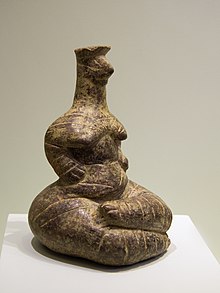
Excavations in South Crete in 2008–2009 revealed stone tools at least 130,000 years old, including bifacial ones of
Stone tools indicate that the island was inhabited by
.For the earlier times, radiocarbon dating of organic remains and charcoal offers some dates. Based on this, it is thought that Crete was inhabited from about 130,000 years ago, in the Lower Paleolithic,[8] perhaps not continuously, with a Neolithic farming culture from the 7th millennium BC onwards. The first settlers introduced cattle, sheep, goats, pigs, and dogs, as well as domesticated cereals and legumes.
Remains of a settlement found under the Bronze Age palace at Knossos date to the 7th millennium BC. Up to now, Knossos remains the only aceramic site. The settlement covered approximately 350,000 square metres. The sparse animal bones contain the above-mentioned domestic species as well as deer, badger, marten and mouse: the extinction of the local megafauna had not left much game behind.
Neolithic pottery is known from Knossos, Lera Cave and Gerani Cave. The Late Neolithic sees a proliferation of sites, pointing to a population increase. In the late Neolithic, the donkey and the rabbit were introduced to the island; deer and agrimi were hunted. The Kri-kri, a feral goat, preserves traits of the early domesticates. Horse, fallow deer and hedgehog are only attested from Minoan times onwards.
Minoan civilization and Mycenaean Period
Crete was the centre of Europe's most ancient civilization, the
(Santorini).Because of a lack of written records, estimates of the
Iron Age and Archaic Crete
The collapse of the Mycenaean civilization was followed by the appearance of the first Greek
Classical and Hellenistic Crete
In the
While the cities continued to prey upon one another, they invited into their feuds mainland powers like
Roman, Byzantine, and Arab Crete
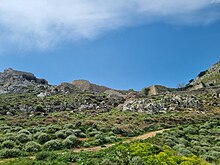
Since 133 BCE western and central Anatolia had been under
Further annexations by Rome, in particular of the Kingdom of Pontus by
The
The Byzantine Greeks held power over the island until the Fourth Crusade (1204). In its aftermath, possession of the island was disputed between the Italian maritime republics of Genoa and Venice, with the latter eventually solidifying their control by 1212. Despite frequent revolts by the native population, the Venetians retained the island until 1669, when the Ottoman Empire took possession of it.
(The standard survey for this period is I.F. Sanders, An archaeological survey and Gazetteer of Late Hellenistic, Roman and Early Byzantine Crete, 1982)
Venetian Crete (1205–1669)
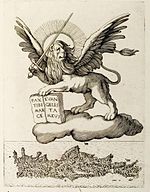
In the partition of the Byzantine empire after the capture of Constantinople by the armies of the Fourth Crusade in 1204, Crete was eventually acquired by Venice, which held it for more than four centuries (the "Kingdom of Candia").
The most important of the many rebellions that broke out during that period was the one known as the
During Venetian rule, the Greek population of Crete was exposed to Renaissance culture. A thriving literature in the Cretan dialect of Greek developed on the island. The best-known work from this period is the poem Erotokritos by Vitsentzos Kornaros (Βιτσένζος Κορνάρος). Another major Cretan literary figures were Marcus Musurus (1470–1517), Nicholas Kalliakis (1645–1707), Andreas Musalus (1665–1721), and other Greek scholars and philosophers who flourished in Italy in the 15–17th centuries.[13]
Ottoman Crete (1669–1898)
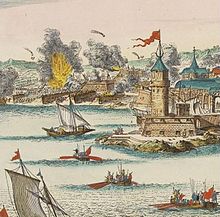

During the Cretan War (1645–1669), Venice was pushed out of Crete by the Ottoman Empire, with most of the island lost after the siege of Candia (1648–1669), possibly the longest siege in history. The last Venetian outpost on the island, Spinalonga, fell in 1718, and Crete was a part of the Ottoman Empire for the next two centuries. There were significant rebellions against Ottoman rule, particularly in Sfakia. Daskalogiannis was a famous rebel leader. One result of the Ottoman conquest was that a sizeable proportion of the population gradually converted to Islam, with its tax and other civic advantages in the Ottoman system. Contemporary estimates vary, but on the eve of the Greek War of Independence as much as 45% of the population of the island may have been Muslim.[15]
Some Muslim converts were
Greek War of Independence (1821)
The Greek War of Independence began in 1821, with extensive Cretan participation. An uprising by Christians met with a fierce response from the Ottoman authorities and the execution of several bishops, regarded as ringleaders. Sultan Mahmud II granted rule over Crete to Egypt's ruler Muhammad Ali Pasha in exchange for his military support. Between 1821 and 1828, the island was the scene of repeated hostilities. The Muslims were driven into the large fortified towns on the north coast and it would appear that as many as 60% of them died from plague or famine while there. The Cretan Christians also suffered severely, losing around 21% of their population in the 1830s.[17]
Crete was subsequently left out of the new Greek state established under the
The island's Christians revolted
The uprising, which lasted for three years, involved volunteers from Greece and other European countries, where it was viewed with considerable sympathy, particularly after the
During the
Disputes between the two powers led to a further insurgency in 1889 and the collapse of the Pact of Halepa arrangements. The international powers, disgusted at what seemed to be factional politics, allowed the Ottoman authorities to send troops to the island and restore order but did not anticipate that Ottoman Sultan Abdul Hamid II would use this as a pretext to end the Halepa Pact Constitution and instead rule the island by martial law. This action led to international sympathy for the Cretan Christians and to a loss of any remaining acquiescence among them to continued Ottoman rule. When a small insurgency began in September 1895, it spread quickly, and by the summer of 1896 the Ottoman forces had lost military control of most of the island.
A new
Modern Crete
Cretan State
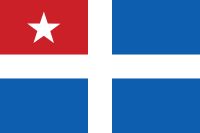
After the expulsion of Ottoman forces in November 1898, the autonomous Cretan State (Official Greek name: Κρητική Πολιτεία), headed by Prince George of Greece and Denmark, was founded under Ottoman suzerainty in December 1898.
Prince George was replaced by Alexandros Zaimis in 1906, and in 1908, taking advantage of domestic turmoil in Turkey as well as the timing of Zaimis's vacation away from the island, the Cretan deputies declared union with Greece.[21] But this act was not recognized internationally until 1913 after the Balkan Wars when, by the Treaty of London, Sultan Mehmed V relinquished his formal rights to the island.
In December, the Greek flag was raised at the Firkas fortress in Chania, with
One of the most important figures to emerge from the end of Ottoman Crete was the liberal politician Eleftherios Venizelos, probably the most important statesman of modern Greece. Venizelos was an Athens-trained lawyer who was active in liberal circles in Chania, then the Cretan capital. After autonomy, he was first a minister in the government of Prince George and then his most formidable opponent.
In 1910 Venizelos transferred his career to Athens, quickly became the dominant figure on the political scene and in 1912, after careful preparations for a military alliance against the Ottoman Empire with Serbia, Montenegro, and Bulgaria, allowed Cretan deputies to take their place in the Greek Parliament. This was treated as grounds for war by Ottoman Empire but the Balkan allies won a series of sweeping victories in the hostilities that followed (see Balkan Wars). Ottoman Empire was effectively defeated in the ensuing war and were forced out of the Balkans and Thrace by the Alliance, except for the borders which Turkey continues to hold to this day.
World War II
Battle of Greece
In 1939, the United Kingdom guaranteed military aid to Greece if its territorial integrity was threatened.[22] The priority of the United Kingdom was to prevent Crete from falling into enemy hands, because the island could be used to defend Egypt, the Suez Canal and the route to India.[23] British troops landed on Crete with the consent of the Greek Government from 3 November 1940, in order to make the 5th Greek Division of Crete available for the Albanian front.
The invasion of mainland Greece by the Axis powers began on 6 April 1941 and was complete within a few weeks despite the intervention of the armies of the Commonwealth along with Greece. King George II and the Government of Emmanouil Tsouderos were forced to flee Athens and took refuge in Crete on April 23. Crete was also the refuge of Commonwealth troops that fled from the beaches of Attica and the Peloponnese to Crete to organize a new front of resistance.
Battle of Crete
After the conquest of mainland Greece, Germany turned to Crete and the last stage of the Balkans campaign. After a fierce and bloody conflict between Nazi Germany and the Allies (United Kingdom, New Zealand, Australia, and Greece) that lasted ten days (between the 20 and 31 May 1941), the island fell to the Germans.
On the morning of 20 May 1941, Crete was the theater of the first major airborne assault in history. The Third Reich launched an airborne invasion of Crete under the code name of "Operation Mercury". 17,000 paratroopers under the command of General Kurt Student were dropped at three strategic locations with airfields:
On 1 June 1941 the Allies completely evacuated the island of Crete. Despite the victory of the German invaders, the elite
The Cretan Resistance

From the first days of the invasion, the local population organized a
Liberation
By late 1944 German forces were withdrawing from Greece to avoid being cut off by the advancing Russian army moving west across Europe. By the end of September, German and Italian troops began withdrawing from Crete, and on October 13 both Rethymno and Heraklion were liberated as the occupying forces were withdrawn to the Chania area.
On May 9, 1945, the German Commander signed an unconditional surrender at the Villa Ariadne at Knossos, effective "10 o'clock Greenwich Mean Time on the tenth day of May 1945”[26]
Civil War
In the aftermath of the
The Lefka Ori region in the west offered more favorable conditions for DSE's insurgency. In the summer of 1947 DSE raided the Maleme Airport, looting its warehouses and abducting 100 aircraftmen of the Royal Hellenic Air Force, 12 of whom joined the rebels. On 4 July 1947, DSE struck a former German motor depot at Chrysopigi on the outskirts of Chania. DSE abducted the depot's guards, looted the warehouse and set it aflame; resulting in a big explosion that led to the mobilization of government troops across the island. Following the destruction of the DSE units in the east, Cretan DSE numbered around 300 fighters. Crop failure during 1947 had created food shortages in Crete which were much more severe among the rebels who lacked access to the cities. The communists resorted to cattle rustling and confiscated 70,000 okades of potatoes from the village of Lakkoi. This solved supply shortages only temporarily and the communists struggled to enforce discipline on their recruits or dislodge the mountain bandits residing in the areas under their nominal control. In the autumn of 1947, the Greek government offered generous amnesty terms to Cretan DSE fighters and mountain bandits, many of whom opted to abandon armed struggle or even defect to the nationalists. On 4 July 1948, government troops launched a large scale offensive on Samariá Gorge. Many DSE soldiers were killed in the fighting while the survivors broke into small armed bands. In October 1948, the secretary of the Cretan KKE Giorgos Tsitilos was killed in an ambush. By the following month only 34 DSE fighters remained active in Lefka Ori. The insurgency in Crete gradually withered away, with the last two hold outs surrendering in 1974, 25 years after the conclusion of the war in mainland Greece.[28]
Other notable historical events
Cretan School of Art
An important school of icon painting, under the umbrella of post-Byzantine art with Latin influences, which flourished while Crete was under Venetian rule during the late Middle Ages, reaching its climax after the Fall of Constantinople, becoming the central force in Greek painting during the 15th, 16th and 17th centuries.
Cretan literature
Due to the economic and intellectual growth observed in Crete during the Venetian era, Cretan literature was rich in quantity and quality and important for the subsequent course of Modern Greek literature. The peaceful living and contact with a developed intellectual and cultural people were the factors that contributed to the cultivation of education and literature and the emergence of remarkable literary production.
The Black Death
As a result of plagues of the
See also
Further reading
- Hopkins, Adam Crete : its past, present and people Faber 1977 ISBN 0-571-10411-8
- McKee, Sally Uncommon Dominion : Venetian Crete and the Myth of Ethnic Purity University of Pennsylvania Press 2000 ISBN 0-8122-3562-2
- On Crete, New Evidence of Very Ancient Mariners by John Wilford, The New York Times, February 15, 2010
References
Notes
- ^ Chris Moorey, A History of Crete (Haus, 2019).
- ^ a b T.F. Strasser, E. Panagopoulou, C.N. Runnels, P.M. Murray, N. Thompson, P. Karkanas, F.W. McCoy, K.W. Wegmann Stone Age seafaring in the Mediterranean: evidence from the Plakias region for Lower Palaeolithic and Mesolithic habitation of Crete Hesperia, 79 (2010), pp. 145-190
- .
- .
- ^ S2CID 239841623, retrieved 2023-04-30
- ^ M. Pavia, C. Mourer-Chauviré An overview of the Genus Athene in the Pleistocene of the Mediterranean Islands, with the Description of Athene trinacriae n.sp. (Aves: Strigidae) Z. Zhou, F. Zhang (Eds.), Proceedings of the 5th Symposium of the Society of Avian Paleontology and Evolution, Beijing Science Press (2002), pp. 13-27
- ISBN 978-3-319-51726-1, retrieved 2023-05-08
- ^ Hemingway, Seán, Art of the Aegean Bronze Age, p. 25, The Metropolitan Museum of Art Bulletin, Spring 2012 Volume LXIX, Number 4
- ^ C.Michael Hogan, Phaistos Fieldnotes, The Modern Antiquarian (2007)
- ^ "Mithradates VI Eupator", Encyclopædia Britannica
- ISBN 978-1-56859-155-1.
- ^ Panagiotakis, Introduction, p. XVI.
- OCLC 309809847.
CALLIACHI, (Nicholas,) a native of Candia, where he was born in 1645. He studied at Rome for ten years, at the end of which time he was made doctor of philosophy and theology. In 1666 he was invited to Venice, to take the chair of professor of the Greek and Latin languages, and of the Aristotelic philosophy; and in 1677 he was appointed professor of belles-lettres at Padua, where he died in 1707.
- OCLC 11558801.
Calliachius (1645–1707) was born on Crete and went to Italy at an early age, where he soon became one of the outstanding teachers of Greek and Latin.
- ^ Excerpts from William Yale, The Near East: A modern history by (Ann Arbor, The University of Michigan Press, 1958)
- ^ A. Lily Macrakis, Cretan Rebel: Eleftherios Venizelos in Ottoman Crete, Ph.D. Dissertation, Harvard University, 1983.
- ^ Panagiotis Krokidas, and Athanasios Gekas, "Public Health in Crete under the rule of Mehmed Ali in the 1830’s." Égypte/Monde arabe 4 (2007): 35-54 online.
- ^ McTiernan, pp. 13–23.
- ^ McTiernan, p. 28.
- ^ McTiernan, pp. 35–39.
- ^ Ion, Theodore P., "The Cretan Question," The American Journal of International Law, April, 1910, pp. 276–284
- ^ Joëlle Dalègre, op. cit., p.20
- ^ Van Creveld, op. cit., p. 67.
- ^ Beevor, op. cit., p. 231
- ISBN 0-14-016787-0.
- ^ "Constantin E. Mamalakis. Crete during the Second World War. Speech at the Historical Museum of Crete 25 June 2009" (PDF). Archived from the original (PDF) on 16 October 2013. Retrieved 14 October 2013.
- ^ Margaritis, pp. 441–447.
- ^ Margaritis, pp. 447–452.
- OCLC 3999247.)
Foreign merchants who chose Lviv as their second home, repaid the city a hundredfold: the Greek from Crete, called Koreto de Candia, whose name was popularly abbreviated into Korniakt, was the most prominent Ukrainian patrician leader in Lviv in the late 16th and early 17th century, erected a beautiful bell-tower on the pattern of Renaissance campaniles attached to the church of Assumption.
{{cite book}}: CS1 maint: multiple names: authors list (link - ISBN 1-894865-03-0.
…the Greek merchants Constantine Korniakt and Manolis Arphanes Marinetos are added. This second redaction appeared no earlier than 1589, as wealthy Greeks began to join the confraternity at a later date, once it had expanded its activities. Korniakt was actually the wealthiest man in Lviv: he traded in Eastern, Western, and local goods, collected customs duty on behalf of the king, and owned a number of villages.
Bibliography
- Margaritis, Giorgos (2006). Ιστορία του ελληνικού εμφυλίου πολέμου 1946-1949 [History of the Greek Civil War 1946-1949] (in Greek). Vol. II. Athens: Vivliorama. ISBN 9608087139.
- Moorey, Chris. A History of Crete (Haus, 2019) excerpt
- Detorakis, Theocharis E. (1986). Ιστορία της Κρήτης [History of Crete] (in Greek). Athens. )
- McTiernan, Mick, A Very Bad Place Indeed For a Soldier. The British involvement in the early stages of the European Intervention in Crete. 1897 – 1898, King's College, London, September 2014.
- Panagiotakis, Nikolaos M. (1987). "Εισαγωγικό Σημείωμα ("Introduction")". In Panagiotakis, Nikolaos M. (ed.). Crete, History and Civilization (in Greek). Vol. I. Vikelea Library, Association of Regional Associations of Regional Municipalities. pp. XI–XX.
- Marie-Louise Winbladh, Minoans and Mycenaeans in west Crete. The Greek-Swedish Excavations at Chaniá, Stockholm 2000.
- Marie-Louise Winbladh, Adventures of an archaeologist. Memoirs of a museum curator, AKAKIA Publications, London 2020
